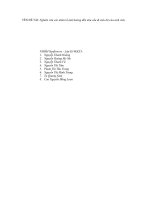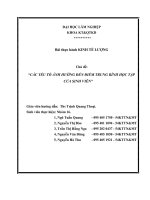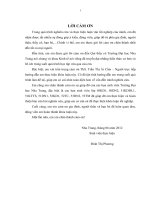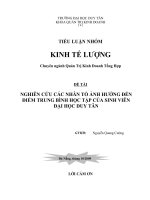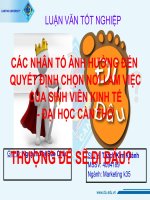factors affecting students’ willingness to communicate in english classroom = nghiên cứu yếu tố ảnh hưởng đến sự tự giác giao tiếp của sinh viên bằng tiếng anh trong lớp học
Bạn đang xem bản rút gọn của tài liệu. Xem và tải ngay bản đầy đủ của tài liệu tại đây (616.77 KB, 50 trang )
VIETNAM NATIONAL UNIVERSITY, HA NOI
UNIVERSITY OF LANGUAGES AND INTERNATIONAL STUDIES
FACULTY OF POST-GRADUATE STUDIES
*********************
PHAN THI
̣
MAI HƢƠNG
FACTORS AFFECTING STUDENTS’ WILLINGNESS TO
COMMUNICATE IN ENGLISH IN CLASSROOM
(NGHIÊN CỨU YÊ
́
U TÔ
́
A
̉
NH HƯƠ
̉
NG ĐÊ
́
N SƯ
̣
TỰ GIÁC GIAO
TIÊ
́
P CU
̉
A SINH VIÊN BĂ
̀
NG TIÊ
́
NG ANH TRONG LƠ
́
P HC)
M.A. MINOR PROGRAMME THESIS
Field : English Teaching Methodology
Code : 60140111
HA NOI-2014
VIETNAM NATIONAL UNIVERSITY, HA NOI
UNIVERSITY OF LANGUAGES AND INTERNATIONAL STUDIES
FACULTY OF POST-GRADUATE STUDIES
********************
PHAN THI
̣
MAI HƢƠNG
FACTORS AFFECTING STUDENTS’ WILLINGNESS TO
COMMUNICATE IN ENGLISH IN CLASSROOM
(NGHIÊN CỨU YÊ
́
U TÔ
́
A
̉
NH HƯƠ
̉
NG ĐÊ
́
N SƯ
̣
TỰ GIÁC GIAO TIÊ
́
P
CA SINH VIÊN BĂ
̀
NG TIÊ
́
NG ANH TRONG LƠ
́
P HO
̣
C)
M.A. MINOR PROGRAMME THESIS
Field : English Teaching Methodology
Code : 60140111
Supervisor : Dr Lê Văn Canh
HA NOI-2014
i
DECLARATION
I hereby, certify the thesis entitled “Factors affecting students’ willingness to
communicate in English in classroom” is the result of my own research for the
Degree of Master of Arts at University of Languages and International Studies,
Vietnam National University, Hanoi. The thesis has not been submitted for any
degree at any other universities or institutions. I agree that the origin of my
paper deposited in the library can be accessible for the purposes of study.
Hanoi, 2014
Phan Thi
̣
Mai Hƣơng
ii
ACKNOWLEDGEMENTS
I am indebted to many whose warm support, cheerful encouragement, and
genuine guidance have been deeply appreciated.
First, I would like to express my immerse gratitude to Doctor Lê Văn Canh,
my supervisor, who has patiently guided me through the research process for his
insightful comments, invaluable guidance, thoughtful suggestions and inspiration.
I am profoundly grateful to all those who participated, the wonderful
students at Hai Phong Private University, who acted as subjects.
I would like to make special mention to my husband, who has given me an
unending supply of all sorts of help and whose support has made it possible for me
to complete this study.
Thanks also go to family and friends for their encouragement.
iii
ABSTRACT
Willingness to communicate (WTC) has gained an increasing amount of attention in
the area of second language acquisition (SLA). Despite the rich findings from
previous researches, most of the previous studies have been conducted in Western
countries. Until recently, little research related to WTC has been conducted in a
foreign language learning (EFL) context where there is usually no immediate
linguistic need for learners to use English in their daily life. The present study
aimed to examine the extent to which the students are willing to communicate in
English in the classroom according to their self-report, and factors that might affect
the students‟ willingness to communicate in an English as a foreign language
context. A mixed-method approach design was employed in order to explore the
different aspects of WTC construct. Data was collected through a questionnaire and
interviews. The participants, 120 Vietnamese tertiary students, completed the WTC
questionnaire. Follow-up interview were then conducted with 12 participants. The
findings of this study shows that students‟ WTC is a complex issue because it is
affected by multiple factors related to the nature of classroom tasks, the students‟
proficiency level and other learner factors. A number of factors that appeared to
affect their WTC in classroom were identified as: self-confidence, language
attitude, self-perceived L2 proficiency, motivation and personality. The results of
this study contribute to the theoretical foundation and methodology of the WTC
construct. This study also provided pedagogical implications for English language
teachers. The limitations of this study and suggestions for future research were also
identified.
iv
TABLE OF CONTENT
PART A: INTRODUCTION 1
1. Rationale 1
2. Aims and objectives of the study 2
3. Research Questions 2
4. Scope of the study 3
6. Design of the study 3
PART B: DEVELOPMENT 4
CHAPTER 1: LITERATURE REVIEW 4
1.1 Definition of Willingness to communicate (WTC) 4
1.2 Heuristic Model of WTC in L2 5
1.3 Factors affecting students‟ WTC 8
1.3.1 Self-confidence 9
1.3.2 Personality 10
1.3.3 Language attitude 10
1.3.4 Motivation 11
1.4 Classroom WTC in L2 12
CHAPTER 2: RESEARCH MOTHODOLOGY 15
2.1 Methodological Approach 15
2.2 Participants and context 16
2.3 Data collection 16
2.3.1 Instruments 17
2.3.2 Data collection procedures 18
2.3.3 Data analysis 18
CHAPTER 3: FINDINGS AND DISCUSSION 19
3.1 Findings 19
3.1.1 Qualitative data (WTC interview) 19
v
3.1.2 Qualitative data: Factors likely to influence L2 WTC 24
3.2 Summary 33
PART C: CONCLUSION 34
1. Concluding remarks 34
2. Pedagogical implications 34
3. Limitations of the study and suggestions for further studies 35
LIST OF REFERENCES 37
APPENDIX A: WTC Questionnaire (English version) I
1
PART A: INTRODUCTION
1. Rationale
Among the four popular foreign languages in Vietnam: English, Chinese, Russian,
and French, English has been the most popular since 1989 in political, economic,
and socio-cultural aspects of Vietnam. One reason for its popularity lies in
Vietnam‟s establishment of diplomatic relationships with 174 countries, and
economic and trade ties with almost all countries and territories in the world.
Evidently, English competence enhances the presence of Vietnamese because
English is used as a means of communication in these organizations. In addition, the
current popularity of English in Vietnam arises from common demand because
English is the key to science, technology and commerce. In terms of how the
popularity of English has influenced common Vietnamese, the processes of
modernization, industrialization, integration, and globalization provide the
Vietnamese with more opportunity to improve their study, work, and living
conditions. However, these processes and opportunities also force them to work
harder to be better prepared for social demands. In particular, Vietnamese more and
more are required to be able to communicate in English and even be fluent in
English for work and study in an international environment.
Modern language pedagogy attaches a lot of importance to communication and
training language learners who are able to communicate effectively in the target
language. In a language classroom following communicative approach, language
teachers are eager to have learners who are willing to use the language in class. The
reason is that researches have shown that a lack of willingness to use the language
results in ineffective interaction and language production. So, it is true that the
notion of Willingness to Communicate (WTC) plays a key role in learning a
second/foreign language. MacIntyre et al. (1998) conceptualized a heuristic model
of WTC in L2 in order to explain the interrelations among affective variables
influencing the WTC in L2. The heuristic model is associated with the perspective
that “authentic communication in a L2 can be seen as the result of a complex system
2
of interrelated variables” (MacIntyre et al., 1998). The heuristic model is also
associated with the perspective that the L2 student‟s intention to communicate
(WTC) is significantly connected to his/her actual L2 communication.
Despite the rich findings from previous researches, most of the previous studies
have been conducted in Western countries. Until recently, little research related to
WTC has been conducted in a foreign language learning (EFL) context where there
is usually no immediate linguistic need for learners to use English in their daily life.
Therefore, understanding the variables that might increase or decrease language
learners‟ opportunities and readiness to speak in language classrooms seems to be
pertinent in today‟s context.
2. Aims and objectives of the study
This study aims at:
(1) Exploring the extent to which students are willing to communicate in English
classes; and
(2) Identifying factors that might affect students‟ willingness to communicate in
English classes.
These two aims are specified into the following objectives:
(1) Gaining understanding of how students participate in English speaking tasks
in the classroom.
(2) Finding out why students participate in classroom tasks and the way they do
3. Research Questions
In order to achieve the above aims and objectives, the study was designed to
find out answers to the following research questions:
1. How willing are the students to communicate in English in the classroom
according to their self-reports?
2. What factors likely affects the students‟ willingness to communicate in the
classroom?
3
4. Scope of the study
The study limits itself to the investigation into how students in one private
university participate in classroom speaking tasks and the factors affecting their
participation. Thus, the study itself is largely a survey study.
5. Methods of the study
A mixed-method approach was adopted in this study to achieve its aims and
objectives.
For the quantitative part of the study, which could find out the general level of
the selected participants‟ WTC, the researcher randomly selected four level 3
classes (30 students each) of students to take part in the questionnaire survey.
For the qualitative part of this study, which could help to find out factors
influencing students‟ WTC, the researcher randomly selected 16 students from the
120 students who had completed the questionnaire to take part in the individual
interviews (four from each class).
6. Design of the study
This thesis consists of three chapters.
Chapter One reviews previous literature and research relevant to the research
questions addressed in this study. It also introduces the fundamental theoretical
knowledge underlying WTC, and reviews some major findings from empirical
research studies concerning L2 WTC. Previous researches are subsequently listed
and as a consequence, two research questions are raised for investigation.
Chapter Two describes the methodological approach employed in the current
study. A mixed-method design is adopted to enrich the data from different
perspectives. The major research instruments, the WTC questionnaire and semi-
structured interviews are identified. This chapter also describes procedures for
collecting and analyzing data.
Chapter Three reports key findings from an analysis of the research data. These
include results based on the use of both quantitative and qualitative research
techniques. Results from a content analysis of the interview data are also
considered. This chapter also summarizes the key findings of this study.
4
PART B: DEVELOPMENT
CHAPTER 1: LITERATURE REVIEW
1.1 Definition of Willingness to communicate (WTC)
WTC is a relatively new variable in SLA. The notion of WTC was originally
introduced with reference to first language communication, and it was considered to
be a personality-based, trait-like predisposition that remained stable across different
communication situations (McCroskey & Richmond, 1991). WTC - (McCroskey &
Baer, 1985, McCroskey 1992) can be defined as the probability that an individual
will choose to initiate communication, more specifically talk, when free to do so
(MacIntyre &Charos, 1996). As such, WTC can be conceptualized as a goal of
second language instruction, a variable that facilitates language learning itself, and
an internal psychological event with socially meaningful consequences. Initiating
communication represents the culmination of a network of processes at both the
cultural and individual levels. In essence, the notion entails an intention to initiate a
communicative behaviour, and this behavioural intention is often predictive of
actual behaviour (MacIntyre, 1994). WTC in L2, however, was reinterpreted as a
situational variable, open to change across situations. It was defined as “a readiness
to enter into discourse at a particular time with a specific person or persons, using
a L2” (MacIntyre, Dörnyei, Clément, & Noels, 1998, p. 547). Specific to a L2
classroom, WTC was defined by Oxford (1997) as “a student’s intention to interact
with others in the target language, given the chance to do so” (p. 449). WTC is also
defined as a learner‟s „„readiness to enter into discourse at a particular time with a
specific person or persons, using a L2” (MacIntyre et al., 1998, p. 547). As
Dörnyei (2003) points out, competence in the L2 may not be enough. Learners need
to be not only able to communicate but also willing to communicate in the L2.
Research has shown that a learner‟s WTC influences how frequently the learner
actively engages in communicating in the L2 (Cle´ment et al., 2003; Yashima et al.,
2004). Thus MacIntyre et al. (1998) propose that WTC in L2 should be
5
conceptualized as the primary goal of language instruction and as a comprehensive
conceptual framework to describe, explain and predict L2 communication behavior.
1.2 Heuristic Model of WTC in L2
MacIntyre et al. (1998) proposed a conceptual pyramid-shaped structure
incorporating a range of potential linguistic and psychological variables that
appeared to influence WTC in L2 (see Figure 1). The level of conceptualisation,
intergroup communication process, and the issue of time were all integrated in this
pyramid model. WTC was identified as a behavioural intention, the final step to
using a L2 with a specific person. They made a distinction between immediate
situational factors and enduring influences that underlie WTC in the L2. The
situational factors (for example, desire to communicate with a specific person and
state communicative confidence at a given time in a given place), which were seen
as more dependent on the specific situation at a given moment of time, were placed
within the first three layers, from the top of the pyramid. The enduring influences
(for example, intergroup motivation, communicative competence, intergroup
climate, and personality), which were comparatively distal and stable factors,
formed the foundation of the pyramid. This model explores the interrelations among
affective variables influencing WTC in L2 that could explain and predict second
language communication. The significance of this heuristic model lay in it being the
“first attempt at a comprehensive treatment of WTC in the L2” as a situation-based
variable (MacIntyre et al. 1998, p. 558). In this model, L2 WTC is conceptualised at
the state level rather than at the trait level (MacIntyre, 2007). The major flaw with
this model, as (MacIntyre, 2003) acknowledged, is that the pyramid is one-
dimensional like a triangle, thus it does not reflect the interrelationship between and
the weighting of the various components (Dörnyei, 2005), and that the transition
from distal influences to proximal effects is not a simple hierarchy, because at times
distal influences such as social situation can bypass proximal ones.
6
Figure 1: MacIntyre et al.’s heuristic model of WTC in L2 (1998)
A considerable number of research studies have been conducted to validate some
parts of this complex pyramid model in both western and Asian contexts. MacIntyre
and his associates carried out several empirical studies in the Canadian immersion
context, with a main focus on the identification of any correlation of WTC with a
number of factors from this model. These studies revealed that the strongest
predictors of WTC in this model included communication anxiety and perceived
communicative competence (Clément, Baker, & MacIntyre, 2003). For example,
Baker and MacIntyre (2000, 2003) compared an immersion (n = 71) to a non-
immersion programme (n = 120) and examined the effects of the programs on some
variables in the model including perceived competence, WTC, frequency of
communication, communication anxiety, and motivation of students who had
English as their L1 and were studying French as their L2. Based on questionnaire
and interview data, it was found that anxiety and perceived competence strongly
predicted WTC and frequency of communication. Similarly, MacIntyre, Baker,
Clément and Donovan (2003b) conducted a study among university-level students
7
(n = 59) to evaluate differences between French immersion and non-immersion
students in terms of WTC, communication anxiety, perceived competence,
integrative motivation and frequency of communicating. All these variables were
measured by a questionnaire survey. The results showed that WTC correlated
strongly with motivation in the immersion group but not in the non-immersion
group. WTC was found to be predicted by communication anxiety but not by
perceived competence in the immersion group. The reverse was true for the non-
immersion group – WTC was predicted by perceived competence but not
communication anxiety. These results lent support to the pyramid model; that
communication anxiety, perceived competence and motivation have a direct
relationship with WTC. A number of recent studies tested MacIntyre et al.‟s (1998)
heuristic WTC model in the EFL contexts including Chinese, Turkish and Korean
contexts (Atay & Gokce, 2007; Cetinkaya, 2005; Kim, 2005; Peng, 2007b). The
studies carried out in these different EFL contexts suggested that WTC is strongly
predicted by motivation, attitudes towards international community, perceived
linguistic self-confidence (a combination of communication anxiety and perceived
communicative competence), and desire to learn English. Peng (2007b) partially
replicated MacIntyre et al.‟s (2003b) study by examining the possible relationship
between integrative motivation and L2 WTC among Chinese college students
learning English in an intensive programme (n = 174). The WTC questionnaire
adapted from MacIntyre et al. (2001) was used to measure the effects of motivation
and social contexts on L2 WTC. Integrative motivation was measured by the
Attitude/Motivation Test Battery used in Hashimoto‟s (2002) study. Peng‟s findings
showed motivation to be the strongest predictor of L2 WTC and that integrative
motivation accounted for a small proportion of variation in L2 WTC. Attitudes
towards the learning situation were not found to predict L2 WTC. Therefore, Peng
argued that motivation was an important impetus in stimulating learners to
persevere in both L2 learning and possibly L2 communication in an EFL context.
8
Cetinkaya‟s (2005) study examined whether MacIntyre et al.‟s (1998) model
explained the relations among social-psychological, linguistic and communication
variables in the Turkish EFL context at the tertiary level (n = 356). Following a
hybrid design to combine both quantitative and qualitative data collection and
analysis procedures, this study employed both questionnaires and interviews. This
study investigated the interrelations among students‟ WTC in L2, motivation,
communication anxiety, perceived communication competence, attitude toward the
international community, and personality. Qualitative interviews were used to
extend and elaborate these quantitative results.
Unlike Peng‟s (2007b) study which found no relationship between attitudes towards
the international community and WTC, structural equation modelling revealed a
consistent relationship between the students‟ WTC in L2 and attitudes as well as
perceived linguistic self-confidence. Students‟ motivation to learn English and
degree of introversion/extroversion were found to be indirectly related to their WTC
through linguistic self-confidence.
In summary, the empirical studies on L2 WTC carried out in different contexts
provide some evidence for the applicability of MacIntyre et al.‟s heuristic model
across contexts. There seems to be a focus on use of quantitative methods in WTC
research such as structural equation modelling to examine the causal relationship
between WTC and its antecedents. The aforementioned studies pinpoint the
influences of affective/individual variables such as motivation, perceived linguistic
self-confidence, motivation and language attitude on WTC. Because of limited time
and effort, the researcher only focused on these mainly affected factors affecting
students‟ WTC in class in this study.
1.3 Factors affecting students’ WTC
In order to gain insight into the relationship between WTC and its determinants, this
section presents a comprehensive review of the empirical research which has
focused on identifying factors that may exert an influence on WTC in L2.In the past
decade, a number of research studies into L2 WTC have been carried out in order
9
to explore the relationships between L2 WTC and various ID variables, such as
personality, self-confidence, attitudes, and motivation (MacIntyre&Charos, 1996;
Yashima, 2002). Among a number of individual variables, self-confidence has been
frequently, by many researchers, found to be the most immediate antecedent of L2
WTC (Yashima, 2002). A number of factors have also been identified as directly or
indirectly predictive of WTC, including personality (MacIntyre&Charos, 1996), L2
attitude and international posture (Yashima et al., 2004), gender and age, and social
support and learning contexts (Clément, Baker &MacIntyre, 2003). Some other
factors such as security, excitement, responsibility, and classroom environment and
so on, have also been found to have an influence on WTC (Kang, 2005). In this
study, four most popular underlying factors that affect students‟ WTC in class
according to previous studies will be discussed.
1.3.1 Self-confidence
In regard to self-confidence, Clément (1986) claimed that it included two
constructs: perceived competence and lack of anxiety, and these two constructs
represent relatively enduring personal characteristics. In contrast to Clément‟s
concept of trait-like self-confidence, MacIntyre et al. (1998) suggested state
communicative self-confidence as indicated in Layer III of their WTC model was a
momentary feeling of confidence which might be transient within a given situation.
For example, in an evaluation situation, an L2 interlocutor may experience a very
high state of anxiety and low perceived competence, even though the individual
may possess considerable and persistent self-confidence across other situations.
According to MacIntyre et al. (1998), L2 self-confidence in Layer IV of their WTC
model is somewhat different from the state communication self-confidence in Layer
III, in that L2 self-confidence in Layer IV stands for “the overall belief in being able
to communicate in L2 in an adaptive and efficient manner”. This self-confidence
can be affected by two components: “the self-evaluation of L2 skills, a judgment
made by the speaker about the degree of mastery achieved in L2”; and language
anxiety when using an L2. Communicative competence, together with experience,
10
contributes to self-confidence. Higher self-perceived communicative competence
leads to higher self-confidence, and perhaps a higher L2 WTC.
In some of earlier empirical research on L2 WTC (MacIntyre & Charos, 1996), self-
confidence has been consistently found to be the most immediate antecedent of L2
WTC. MacIntyre and Charos (1996) postulated that the intention or willingness to
engage in L2 communication was determined by “a combination of the student‟s
perception of his or her second language proficiency, the opportunity to use that
language, and a lack of apprehension about speaking”.
1.3.2 Personality
Based on earlier research results that introverted people are less likely to
communicate than are extraverts, McCroskey and Richmond (1990) have proposed
that the personality trait dichotomy of introversion/extraversion is an antecedent to
WTC. According to McCroskey and Richmond (1990), introverts are not required
to communicate as often as they tend to be less socially active than extraverts;
however, extraverts, on the other hand, require communication to facilitate social
interaction and place a higher value on communication. Therefore, extraverts are
more likely to be willing to communicate and have a stronger willingness to
communicate than the introverts. In MacIntyre et al.‟s (1998) model, although
personality is not conceptualized as a direct influence on an individual‟s L2 WTC, it
still plays an indirect role on WTC through other affective variables such as
attitudes, motivation, and confidence. For example, the possession of a certain
personality can predict how an individual will react to members of the L2
community in regard to L2 communication. An L2 student with an authoritarian
personality type may avoid having communication with L2 community members.
Thus, personality was found to be indirectly related to L2 WTC through linguistic
self-confidence.
1.3.3 Language attitude
A number of L2 researchers such as Gardner, MacIntyre, Spolsky have claimed that
language attitude is one of the most important factors in predicting the level of
11
success in SLA. In order to describe language attitudes, Gardner (1980) refers that
“the concept „attitude‟ will be used to denote the sum total of a man‟s instinctions
and feelings, prejudice or bias, preconceived notions, fears, threats and convictions
about any specified topic”. In regard to the roles of attitudes in relation to the
learning situation in SLA, L2 researchers have hypothesized that positive attitudes
toward the learning situation are important for the success of SLA. It is likely that
L2 students with positive attitudes tend to consider L2 learning as enjoyable and
beneficial, which may motivate the L2 students to be more active in performing
classroom activities in the L2. Naiman et al. (1975) found significant correlations
between the measure of attitudes and L2 students‟ volunteering by raising a hand in
class, and between L2 students‟ volunteering and the amount of effort they spent on
L2 learning; L2 students with positive attitudes toward L2 learning would volunteer
more in class, and reported studying hard to learn the L2 (cited in Gardner et al.,
1978). It is probable that more active participation and effort in L2 learning can
enable L2 students to achieve more significant results in L2 learning. Consequently,
language attitude is an important factor in predicting the level of success in SLA.
1.3.4 Motivation
In agreement with many other L2 researchers, Gardner (1985, 1988) argues that
motivation is one of the important factors in predicting the success of SLA. Gardner
claims that motivated L2students extend their active and personal involvement in
L2 learning, which can enable them to achieve successful L2 acquisition. Because
of the importance of motivation in SLA, L2 researchers argue that it is important for
L2 educators and researchers to understand why L2 students learn their target L2.
To explore factors of influencing the L2 student‟s motivation, Gardner and Lambert
(1959) first made a distinction between instrumental and integrative motivation.
According to Gardner and Lambert, instrumental motivation refers to the L2
student‟s desire to learn his/her target L2in order to achieve his/her practical
purposes such as acquiring good grades in school, securing a job, or obtaining a
promotion. On the other hand, integrative motivation is related to the L2 student‟s
12
willingness to identify with members of his/her target L2 community. At the early
stage of conceptualizing motivation, Gardner and Lambert (1959) considered
integrative motivation as superior to instrumental motivation in determining success
of SLA (cited in Gardner &MacIntyre, 1993). Gardner and Lambert hypothesized
that integratively motivated L2 students might be more active in participating in the
L2 classroom, and maximize the opportunities to interact with members of their
target L2 community out of the L2 classroom. Active interactions with L2 members
could enable L2 students to achieve L2 proficiency, especially in the oral aural
features of proficiency. It is shown that students who enter the intensive program
with positive attitudes toward foreign language as an integrative motive appear to
be much more successful in developing oral skills and perceive the program as more
rewarding than those who are not similarly motivated.
1.4 Classroom WTC in L2
Some researchers (Dornyei 2005; MacIntyre et al. 1998, 2003) have argued that the
ultimate goal of language instruction should be the creation of WTC in the language
learning process. Given the relevance of WTC to language teaching and learning, it
seems important to examine WTC as specific to the L2 classroom context, by
considering the influence of the underlying variables of learners‟ WTC. There has
been increasing to research on WTC as situated in L2 classrooms and this body of
research has investigated a number of areas in both ESL and EFL settings, including
examination of learner perceptions of their WTC in L2 in class.
Some research has focused on learner perceptions of WTC in class. For example,
House (2004) investigated learner perceptions of factors contributing to WTC in L2
among ESL learners, and relationships existing between these factors, through the
use of diaries and interviews. Six learners were asked to report their experiences
over a 5-week period, and how perceptions of these experiences influenced their
WTC inside the language classroom. The results showed that WTC in L2 was
affected by whether learners take up opportunities that they perceive as suitable for
actually engaging in L2 communication. He also found that factors such as
13
perceived politeness, the role of physical locality, the presence of the opposite sex,
mood, and the topic under discussion were minor influences affecting WTC.
House‟s study was the first attempt to enable learners‟ perceptions of WTC to be
voiced and heard. Cao and Philp (2006) compared self-reported WTC and WTC
behaviour in class. This study employed triangulation as a technique to compare
ESL learners‟ (n = 8) self-report of WTC to their actual WTC behaviour in three
interactional classroom settings (whole class, small groups and dyads) and how
their WTC behaviour differed in each of these contexts. The results indicate that
learners‟ self-reports of WTC are not necessarily predictive of their actual
classroom behaviour. It was also found that situational WTC could change in the
classroom across the three interactional contexts, under the influence of situational
variables such as group size, familiarity with interlocutors, the familiarity and
interest of topic of discussion, and the confidence of the learner in relation to the
task. This study supported the use of classroom observation as an appropriate way
to tap situational WTC in L2 in class. Another study that employed the
triangulation technique in investigating WTC in L2 was Liu‟s (2005) study. This
study examined Chinese tertiary students‟ reticence in oral English language
classroom by employing questionnaires, classroom observations and reflective
journals (n = 27). The study found that the factors that prohibited students‟ WTC in
class were lack of practice, low English proficiency, lack of self-confidence,
anxiety, cultural beliefs, personality, and fear of losing face. This study highlighted
the importance of searching for reticence-coping strategies to promote learners‟
WTC in class.
Weaver‟s (2004) studies examined situational variables underlying WTC in L2
classrooms in relation to task types. His study (2004) investigated Japanese
learners‟ WTC (n = 1104) within an L2 classroom at tertiary level. Unlike previous
studies that exclusively adopted the WTC scale developed by McCroskey and
Richmond (1990) in their questionnaire surveys, this study used a questionnaire
developed by the researcher himself to investigate whether or not learner‟s L2 WTC
14
would vary across 17 speaking situations and tasks potentially arising in this social
context of a L2 classroom. The findings revealed that students‟ WTC varied
significantly across different speaking situations and tasks and suggest that task is a
variable likely to contribute to changes in WTC in L2 classrooms. From the review
in the preceding sections of recent WTC studies carried out in different contexts, it
can be seen that the WTC research still bears a very close relation to the most
comprehensive theory of the WTC in L2 construct proposed by MacIntyre and
associates (1998). It is noteworthy that the research is limited to employing a
quantitative approach with data collected mainly from self-report questionnaires and
with data then being subjected to statistical analysis to identify causal or
correlational relationships between WTC and its predictors.
15
CHAPTER 2: RESEARCH MOTHODOLOGY
2.1 Methodological Approach
The key issue associated with designing a mixed-method research design is how to
combine quantitative and qualitative research effectively. A quantitative research
approach focuses on gathering numerical data and generalizing it across groups of
people. In contrast, a qualitative approach is based on descriptive data that does not
make use of statistical procedures. Quantitative and qualitative approaches have
their own separate strengths and weaknesses. Quantitative research can produce
reliable and replicable data that is generalizable to other contexts, but is generally
not very sensitive in uncovering the reasons for particular observations or the
dynamics underlying the examined situation or phenomenon. That is, the general
exploratory capacity of quantitative research is rather limited (Dörnyei, 2007).
Qualitative research, on the other hand, has traditionally been seen as an effective
way of exploring new, uncharted areas (Dörnyei, 2007), and describing second
language acquisition in its natural context. However, Duff (2006) has warned that
although qualitative research may be helpful in providing insights into a
phenomenon, the specific conditions or insights may not apply broadly to others
(Dörnyei, 2007). Therefore, mixed -method research which is a combination of
quantitative and qualitative methods within a single research project has become
common in recent years. In this way , we can gain a better understanding of a
complex phenomenon by converging numeric trends from quantitative data and
specific details from qualitative data (Dörnyei, 2007), and therefore arrive at a more
multidimensional and accurate view of the process of second language acquisition .
As a result, combining a qualitative approach with a quantitative approach in the
current study should provide fuller, deeper, more meaningful answers to a single
research question (Johnson & Christensen, 2008), and enrich the ability of the
researcher to draw conclusions about the problem under study (Dörnyei, 2007). The
research design for this study was adapted from the design by Cao (2009) who
studied the dynamics of WTC of the students studying English in New Zealand.
16
2.2 Participants and context
120 non-major students from 4 different classes studying English at Level 3 at
Haiphong Private University were chosen as participants in this research. The
researcher randomly selected four level 3 classes (n=120) of students to take part in
the questionnaire survey. The participating students, aged from 19-22, had studied
English as a school subject for 3 years at junior high school and were in the first or
second year of their university. It is expected that students at this level have
developed basic speaking skills after at least three or four years of study. According
to the researcher‟s previous experience teaching in this school, the students have
few opportunities to speak English outside classrooms as there is almost no chance
to contact with foreigners. However, guided by the national curriculum, one present
goal of Vietnamese Ministry of Education is to develop an all-round ability to use
English, that is, to develop their skills in listening, speaking, reading, and writing.
Just as MacIntyre et al. (1998) indicate, the aim of language teaching should
ultimately be to foster learners‟ willingness to engage in communication and their
willingness to talk in order to learn. Therefore, communicative interaction is
increasingly justifying its place in the Vietnamese classroom. Classroom
management takes on more communicative characteristics with various types of
group work and pair work. Teachers are encouraged to cultivate students‟
communicative competence. The target population in this school, therefore, is an
appropriate one for the goal of this study.
2.3 Data collection
For the quantitative part of the study, the researcher randomly selected four
different classes at level three to take part in the questionnaire survey.
For the qualitative part of this study, the researcher randomly selected 16 students
from the 120 students who had completed the questionnaire to take part in the
individual interviews (four from each class). The sampling procedure for the
interviews was simple random sampling, in which each of these 120 students had
“an equal and independent chance of being selected” (Fraenkel&Wallen, 2000).
17
The interview participants were randomly selected by the researcher. It was hoped
that the researcher would be able to interview both willing and less willing -to-
communicate students. The oral English class was offered once per week in a forty-
five-minute session taught by native Vietnamese English teachers, who are all
professionally qualified, at least with Master Degree on Pedagogical Teaching
Methodology. Interview data were collected on an MP3 recorder.
2.3.1 Instruments
2.3.1.1 Questionnaires
A questionnaire is one of the most common methods used to collect data on
attitudes and opinions from a large group of participants, and has been used to
investigate a wide variety of questions in SLA. The advantages of collecting data
through the use of a questionnaire include the provision of answers to questions in a
systematic and disciplined way, relative ease of construction, extreme versatility,
and the ability to gather a large amount of information in a comparatively short
amount of time and a readily usable form (Dörnyei, 2007). Moreover, the aim of
using questionnaire in research fits the purpose of the study.
In this study, Cao‟s (2009) questionnaire was adopted. The questionnaire consisted
of 15 items related to students‟ willingness to engage in communication tasks
during class time. It covered situations or tasks that students were familiar with or
found easy to imagine, and with differing amounts of cognitive demand. The 15-
item WTC scale was administered with instructions which asked students to
indicate how willing they would be to initiate communication on a percentage scale
(0-100%) in each of the 15 situations. The questionnaire was translated into
Vietnamese so it was much easier for students to understand and complete it.
2.3.1.2 Interviews
In order to understand deeply about Vietnamese students‟ willingness to
communicate in English and the factors affecting this willingness, results of the
questionnaire were extended and elaborated by the use of qualitative interviews
with participants.
18
In order to examine the selected students‟ attitudes towards the English speaking
international community, the researcher interviewed 16 randomly chosen students
from 120 participants in a quiet room (the teachers‟ lounge) and the fifteen
questions in WTC Interview Questions (see Appendix) are asked.
In case the interviewees might have difficulty understanding the questions in
English or do not like speaking English, and in order to increase the validity of the
interviews, all the interviews were carried out by the researcher in Vietnamese.
2.3.2 Data collection procedures
Firstly, the researcher focused on the completion and collection of the WTC
questionnaires. The participants were informed that their participation was entirely
voluntary and that their participation in this study would not affect their
achievement as well as their grades. The participants were also informed that the
data would be collected anonymously and kept confidential by the researcher. The
questionnaires took about seven minutes of class time to complete.
The next step of data collection involved face-to-face interviews with the 16
randomly-chosen participants from these four classes. The participants received the
interview questions one day before the interview so they could have enough time to
prepare their answers. The interviewees were informed of the purpose of the study
and assured that their responses would be confidential. Interviews were conducted
by the researcher in a quiet lounge. Each interview took between ten to fifteen
minutes and was recorded in an MP3 player.
2.3.3 Data analysis
The questionnaire data were used to identify the general level of the selected
participants‟ WTC. Quantitative data from questionnaires were also factor analyzed.
These factors then become themes that were compared with themes analyzed from
the qualitative interview data. Interview data were analyzed qualitatively in order to
reveal factors that seem to contribute to the selected participants‟ willingness to
communicate in English in classroom. Then the research‟s result will be compared
to previous studies on this field.

